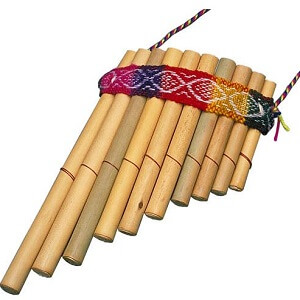Panflute
 The pan flute or panpipes (syrinx) was a musical wind instrument first used by the ancient Greeks. Most commonly played by shepherds, the earliest use was in the Cycladic islands in the third millennium BCE, and representations of the instrument run right through the history of Greek art.
The pan flute or panpipes (syrinx) was a musical wind instrument first used by the ancient Greeks. Most commonly played by shepherds, the earliest use was in the Cycladic islands in the third millennium BCE, and representations of the instrument run right through the history of Greek art.
Although in some accounts the invention of the instrument was attributed to Cybele or Hermes, the deity most closely associated with the panpipes and widely credited with its invention was the pastoral god Pan. In Greek mythology, Pan, the patron of shepherds, fell in love with the Nymph Syrinx, daughter of Ladon the river-god.
Panpipes were constructed from four to eighteen cane tubes (without any lateral holes) which were fastened together using cane, flax, or wax. Played by holding the instrument in both hands and blowing across the top end of each tube, different notes were produced with different lengths of tubes or by equal length tubes blocked at different points by wax. The sound produced was deep and rich.